
The Aqueduct of Luynes is a former Gallo-Roman bridge aqueduct located in Luynes, France.

The Aqueduct of Luynes is a former Gallo-Roman bridge aqueduct located in Luynes, France.
The remains show a stack of five arches and it is the most famous Roman monument in the Department of Indre-et-Loire, despite its modest dimensions. It is also one of the best preserved of the Northern aqueducts. It was classified a historical monument in 1862 and is owned by the town of Luynes.
It originally had a total length of 1,825 metres (5,988 ft), almost in a straight line, including 525 metres (1,722 ft) of raised causeway. Its underground portion, and in particular its final journey, passes the hamlet of Villeronde. [1] [2] Only a portion of the aqueduct-bridge is now visible as it passes through the "Valley of the Arennes". [3]
The actual channel for the water is masonry and not a lead or terracotta piping and has a slope of 1.5 cm to 2.9 m per kilometre. The maximum height of the arches of the aqueduct is 8.90 m.
The remains of the aqueduct-bridge are located 1.5 km northeast of the centre of Luynes, in Indre-et-Loire. It has a general orientation of north-northeast to south-southwest, taking water from the now dry Pie Noire (or Pinnoire), [4] and is believed to have supplied water to ancient Luynes, [5] or even Caesarodunum. [6]
It has been conjectured, however, that the aqueduct was privately owned and serviced the complex of private villas at Sainte-Roselle. [7] [8] Its construction has not yet been dated with certainty; the construction style would indicate the 2nd or 3rd century, like the resort that it fed.
It remained in use until the 12th or 13th century and has been the subject of several repair campaigns, especially at the beginning of the 10th century, under Charles the Simple, [9] which is why it has survived so well, even if number of stones of its collapsed piles had to be recovered and used. This suggests that its use has changed throughout this period, despite the abandonment of the seaside resort of Sainte-Roselle.

Luynes is a commune in the Indre-et-Loire department in central France.

The Viromanduī or Veromanduī were a Belgic tribe dwelling in the modern Vermandois region (Picardy) during the Iron Age and Roman periods. During the Gallic Wars, they belonged to the Belgic coalition of 57 BC against Caesar.
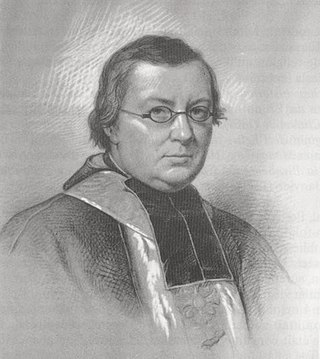
Jean-Jacques Bourassé was a French Roman Catholic priest, archaeologist and historian. He made his preparatory studies for the priesthood in Paris. In 1835, he taught the natural sciences at the preparatory seminary of Tours, where he began a course of archaeology that soon attracted attention. The results achieved by him in a comparatively new field of research were such as to entitle him to be considered a veritable pioneer in France of the science of Christian archaeology. In 1884 he became professor at the grand séminaire and held the chair of dogmatic theology there for six years. He then discontinued teaching in order to devote himself entirely to the preparation of his various archæological works. Among the productions published by him the best known are: Archéologie Chrétienne (1841); Les Cathédrales de France (1843); Les plus belles églises du monde (1857); Recherches historiques et archéologiques sur les églises romaines en Touraine (1869).
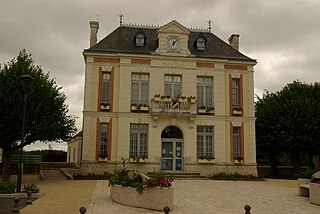
Chambourg-sur-Indre is a commune in the department of Indre-et-Loire in the region of Centre-Val de Loire, France.
Augusta Viromanduorum is an ancient Gallo-Roman settlement, corresponding to the modern city of Saint-Quentin.

The Roman-Gaul Baths of Entrammes is a complex of Gallo-Roman thermal baths (thermae) in Entrammes, Mayenne, France. The baths were partially incorporated into a church with the hypocaust surviving below the new structure. The remains were discovered in 1987.

The Tours amphitheater is a Roman amphitheatre located in the historic city center of Tours, France, immediately behind the well known Tours cathedral. It was built in the 1st century when the city was called Caesarodunum. It was built atop a small hill on the outskirts of the ancient urban area, making it safe from floods, convenient for crowds and visitors, and demonstrating the power of the city from a distance. The structure was an enormous, elliptical structure approximately 122 meters by 94 meters. According to its design it is classified as a "primitive" amphitheatre. Unlike the famous Colosseum that was made mostly of masonry and built above-ground, the Tours amphitheatre was made mostly of earth and created by moving soil and rock into a bowl shape. Spectators likely sat directly on the grassy slopes, while the masonry was primarily used for the vomitoria and retaining walls.
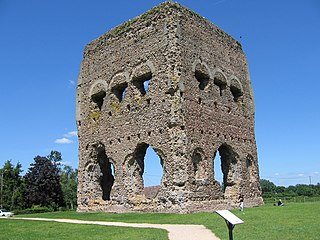
The "Temple of Janus" is a Romano-Celtic religious structure located in Autun, Saône-et-Loire, France, to the North-West of the ancient city of Augustodunum.
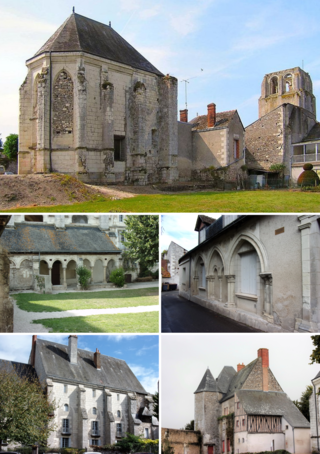
Cormery Abbey or the Abbey of Saint Paul, Cormery, is a former Benedictine abbey located on the territory of the commune of Cormery in the French department of Indre-et-Loire in the Centre-Val de Loire region.

The Jublains archeological site is a cluster of ruins, mostly dating back to Ancient Rome, in the current French commune of Jublains in the département of Mayenne in the Pays de la Loire.
Michel Laurencin was a French academic and historian who specialized in the history of Touraine.

Beaugerais Abbey is a former Cistercian abbey, located in what is now the commune of Loché-sur-Indrois, in the Indre-et-Loire département of France.

The Cinq-Mars pile is an ancient tower that overlooks the Loire Valley in the commune of Cinq-Mars-la-Pile, located in Indre-et-Loire, approximately twenty kilometers west of Tours.

The pillar of Yzeures-sur-Creuse is an ancient monumental column constructed from Jurassic limestone with shell inclusions. Some remnants were discovered in and near the foundations of the former church of the French commune of Yzeures-sur-Creuse, in Indre-et-Loire in 1895.
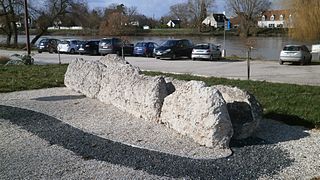
The Fontenay aqueduct, also known as Aqueduc du Cher, is a largely underground aqueduct that helped supply water to the ancient city of Caesarodunum, alongside springs, wells, and another intramural aqueduct. It owes its most common name to a locality near Bléré, where its starting point was located, some 25 kilometers east-southeast of Tours, close to a main spring; the water table from which it springs is still exploited in the 21st century. The aqueduct was also fed by several smaller springs along the way.

A pile, also known as a Roman pile, Gallo-Roman pile, or funerary pile, is a specific type of funerary monument in the archaeological vocabulary of France: elevated towers, typically square or rectangular in plan, with circular forms being less common. Their primary function was to serve as funerary structures within Roman Gaul.

The Chapel of Saint-Libert was a former Romanesque church dated since the 12th century. It was situated within the historic core of Tours, France. Its construction was partially influenced by the Gallo-Roman castrum along the Loire River, with which it shares a portion of the original rampart. The church's nave has been included in the supplementary inventory of historical monuments since December 2, 1946, at the initiative of the Archaeological Society of Touraine (SAT).

The ancient bridges over the Loire in the Touraine area were wooden structures erected during the Roman Empire to facilitate river navigation close to Fondettes and Tours, then known as Caesarodunum. Two bridges, constructed in the 1st century, appear to have been operational concurrently. The third bridge, erected in the early 4th century when walls enclosed the city, superseded the preceding two bridges, which were subsequently dismantled.

The Châteliers oppidum is a French archaeological site located in Amboise, in the Indre-et-Loire department, in the Centre-Val de Loire region. The site is strategically situated on a limestone spur approximately 50 meters above the confluence of the Loire and one of its tributaries, the Amasse. It overlooks the modern city of Amboise, with the medieval Amboise castle situated at its end.